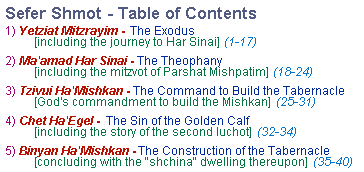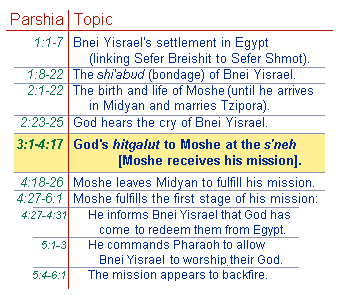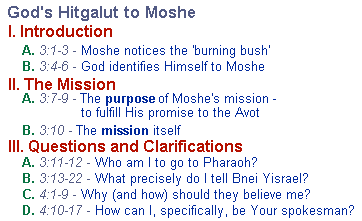Introduction to Sefer Shemot
What is Sefer Shmot?
Before we talk about what "Shmot" means, let's first explain what the word "sefer" implies.
In our study of Chumash [the five 'books'], we work under the basic assumption that each "sefer" [book] carries a unique theme. Therefore, as we study each sefer we attempt to identify that theme. Then, we consider that theme in our study of each individual chapter or unit.
In our study of Sefer Breishit, we employed this approach to uncover its primary theme of "bechira." Now, in our study of Sefer Shmot, we employ a similar approach to uncover its own theme, as well as its connection to that of Sefer Breishit.
So what binds Sefer Shmot together? As we will now show, this is not an easy question to answer.
A Table of Contents
To identify a common theme, it is helpful to first make a list of the major topics of each Sefer and then find what connects these topics together. Let's do this for Sefer Shmot.
If we search for the most general categories, I think that everyone would agree with the table of contents for Sefer Shmot as shown in Board #1. To identify the overall theme of Sefer Shmot, we must find a theme that connects all of these topics together.

Board #1
We can readily understand why Sefer Shmot begins with the story of Yetziat Mitzrayim, as that story naturally continues the narrative of Sefer Breishit. Additionally, this story also rounds out the "bechira" theme of Sefer Breishit. Recall God's opening promise to Avraham Avinu that he will become a goy gadol - a great nation (see 12:1-3). Now, Sefer Shmot begins by explaining how they became that great nation.
[As we explained in our shiur on Parshat Vayigash, the final stage of the "bechira" process was God's choice of all of Yaakov's children to become His special nation. In God's final "hitgalut" to Yaakov Avinu in Sefer Breishit (see 46:1-4), He informs Yaakov that his family will become a great nation in Egypt. The Chumash then presents a detailed list of the shmot of all Yaakov's offspring who went to Egypt (see 46:8-27). This may explain why Sefer Shmot begins with this very same list of names - "v'eyleh shmot" (1:1) - and continues to relate the story of how Bnei Yisrael indeed became that great nation.]
Recall as well that in His covenant with Avraham ("brit bein ha'btarim" - 15:13-18), God informed Avraham that his children will endure a period of slavery and oppression in a foreign land prior to their emergence as a great nation. Therefore, the story of how that enslavement begins - the first part of Sefer Shmot - sets the stage for God's fulfillment of that covenant.
The next major topic - "Ma'amad har Sinai" - flows directly from the story of Yetziat Mitzrayim. One of the primary reasons that God took Bnei Yisrael out of Egypt was in order to give them the Torah (see Shmot 3:12, Rashi and Ramban). As we will see, Ma'amad Har Sinai in fact enhances God's covenant of "brit milah" (see Breishit 17:7-9), in that it explains how Bnei Yisrael are to become God's special nation.
From this point on, however, the progression of topics in Sefer Shmot becomes more difficult to ascertain. Considering that Bnei Yisrael arrive at Har Sinai to receive the entire Torah, we would expect Sefer Shmot to record all the mitzvot they received at that time. Instead, Sefer Shmot records only some of those mitzvot (the "dibrot" and Parshat Mishpatim), and then focuses primarily on the mitzvot relating to the Mishkan. The rest of the mitzvot (given at Har Sinai) are recorded elsewhere in Chumash - in either Vayikra, Bamidbar, or Devarim. Therefore, our conclusion as to the theme of Sefer Shmot must consider why it records only certain mitzvot and why its focus shifts solely to the Mishkan.
Galut and Geulah
Ramban, in his short introduction to Sefer Shmot, attempts to tackle these questions.
After defining Sefer Breishit as "sefer ha'yetzira" [the creation of the world and Am Yisrael (and the patterns of its history)], Ramban (before 1:1) proceeds to explain why Sefer Shmot begins with the story of Yetziat Mitzrayim:
"... after completing Breishit, a special sefer is dedicated to describe the first 'galut' as specifically decreed [in Sefer Breishit, see 15:13-16] and [Bnei Yisrael's] redemption from that galut..."
Next, Ramban must explain the jump in Sefer Shmot from Yetziat Mitzrayim to Ma'amad Har Sinai, and then to the Mishkan:
"... and the galut is not over until they [Bnei Yisrael] return to the level of their forefathers ... and even once they achieve their freedom from Egypt, they are not considered redeemed yet, for they still wander in the desert ... But once they arrive at Har Sinai to receive the Torah and build the Mishkan, and God's shechina dwells upon them - then they return to the level of their forefathers ... and are then considered totally redeemed ..."
Although one could argue with Ramban's conclusions, he clearly assumes - as we did in our introduction - that we should expect to find a unique theme for each sefer of Chumash. [In fact, Ramban opens his pirush to each "sefer" of Chumash with an attempt to identify its overall theme.]
In our study of Sefer Shmot, we will follow a direction similar to Ramban's, showing how Sefer Shmot indeed focuses on how God fulfills His covenants with the Avot. First, we will show how the events of Yetziat Mitzrayim relate to God's fulfillment of "brit bein ha'btarim," and later, how the events at Ma'amad Har Sinai expand upon "brit milah." Afterward, we will show how (and why) the Mishkan can be viewed as an extension of Ma'amad Har Sinai, and we will conclude by showing the thematic connection between "chet ha'egel," the Mishkan and Ma'amad Har Sinai.
More specifically, our opening shiur (on Parshat Shmot) will discuss the significance of God's "hitgalut" to Moshe Rabbeinu at the burning bush, while the shiurim on Parshiyot Va'eyra and Bo will focus on Moshe's mission to prepare Bnei Yisrael for their redemption. Parshat B'shalach will explain the reason for the various events that take place during Bnei Yisrael's journey from Egypt to Har Sinai. In Parshiyot Yitro and Mishpatim we will discuss the events at Ma'amad Har Sinai and the special nature of the mitzvot in Parshat Mishpatim. Finally, our shiurim from Parshat Terumah through Parshat Pekudei will focus on the conceptual relationship between the Mishkan, Ma'amad Har Sinai and "chet ha'egel."
As usual, it is highly recommended that you use the study questions to prepare for the shiurim (even though the shiurim are written so that you can follow even without advanced preparation). Also, it is helpful to study using a Tanach Koren (or similar). This will make it much easier for you to determine the flow of topic and theme from 'parshia' to 'parshia.' B'hatzlacha!
Sefer Shmot and Parshat Shmot
We conclude our introduction with a short shiur that will help explain how Parshat Shmot 'sets the stage' for the upcoming events in Sefer Shmot.
In our shiurim on Sefer Breishit, we showed how its primary theme - "bechira" - was first introduced in God's opening "hitgalut" to Avraham Avinu. As we saw, that theme emerged as the primary topic in each subsequent "hitgalut" to the Avot. We similarly find the primary theme of Sefer Shmot first introduced in God's opening "hitgalut" to Moshe Rabbeinu at the burning bush (see 3:1-4:17).
Even though this "hitgalut" is described only in chapter three, the first two chapters of Sefer Shmot could be understood as its 'backdrop.' Chapter one tells of Bnei Yisrael's becoming a nation in the land of Egypt (see 1:1-7), thus fulfilling God's promise to Yaakov in the final "hitgalut" of Sefer Breishit (see 46:3-4 and our shiur on Vayigash), and of their enslavement (see 1:8-22), as foreseen in "brit bein ha'btarim" (Breishit 15:13-15). Chapter two informs us about the life of Moshe Rabbeinu, from his birth through the episode at the "sneh" [the burning bush].
Using Outlines
Before we conclude our introductory shiur, I'd like to use Parshat Shmot as an example to show how 'outlining' the flow of 'parshiyot' serves as an excellent study tool (especially when searching for a central theme). [I recommend trying this on your own as you study each weekly Parsha.]
Board #2, which organizes Parshat Shmot (Shmot 1:1-6:1) by its individual 'parshiyot,' shows the centrality of God's "hitgalut" to Moshe Rabbeinu at the "sneh" in Parshat Shmot. [Note as well how the mission Moshe receives at the "sneh" - i.e. to take Bnei Yisrael out of Egypt - emerges as the primary topic.]

Board 2
As we will see in the shiurim that follow, the next set of parshiyot (chapters 6-17) describes how Moshe actually completes this mission.
God's Message at the Sneh
What was the purpose of the "hitgalut" at the burning bush? As we will discuss in our shiur on Parshat Shmot, it did much more than just supply Moshe Rabbeinu with some information. God gives Moshe a mission and explains its purpose.

Board 3
To better appreciate this point, Board #3 organizes this entire 'parshia' (3:1-4:17) to show its development. Let's explain:
First, God identifies Himself to Moshe Rabbeinu (I) and then explains to him the mission and its purpose (II). At the center of this outline lies God's charge to Moshe that he take Bnei Yisrael out of Egypt (II-B). Finally, Moshe responds to this assignment by asking several questions regarding how he is to accomplish his mission (III).
In our shiurim on Parshat Shmot and Va'eyra, we explain what this mission is all about, noting that Moshe actually receives a double mission.


This website is constantly being improved. We would appreciate hearing from you. Questions and comments on the classes are welcome, as is help in tagging, categorizing, and creating brief summaries of the classes. Thank you for being part of the Torat Har Etzion community!